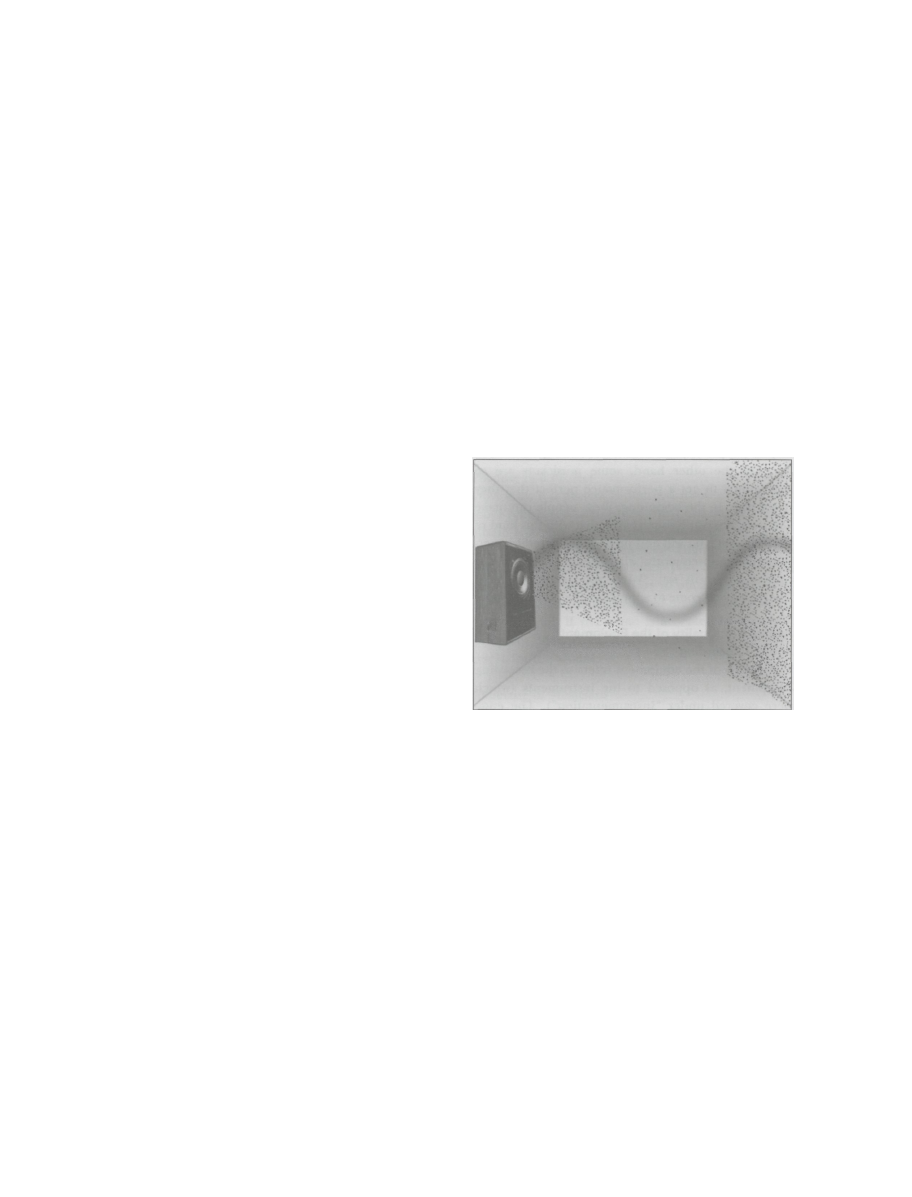ВУЗ: Казахская Национальная Академия Искусств им. Т. Жургенова
Категория: Книга
Дисциплина: Не указана
Добавлен: 03.02.2019
Просмотров: 7464
Скачиваний: 197

when an experienced producer or professional musi-
cian makes a comment or suggestion that works. After
awhile, you will learn an entire range of tips and tech-
niques that you can use to help musicians play better.
DYNAMICS
There are two main types of dynamics that you can
critique and help refine. First, it is a good idea to
keep an eye on simple changes in volume dynamics in
a performance. You might find them to be too
dynamic when they vary too much. Or you might find
them to be too stable in volume, so that it sounds like
a synthesizer or drum machine. It is important to
make sure that the volume dynamics fluctuate in a
way that is musical or appropriate for the song.
The second dynamic to critique is the level of
emotional intensity at every moment in the song. Just
as with volume dynamics, you might find them to vary
too much, be too boring, or be inappropriate. For
example, singers occasionally sing out too intensely at
the beginning of a song when perhaps they should be
saving it for the end of the song. On the other hand,
maybe they need to put more emotion and feeling
into the performance right up front.
Checking out the performance dynamics at
each moment in the song can help you fashion it in
exactly the way you want.
GREATNESS
This is the "goosebump" factor. You should never let
a performance go . . . until it turns you on. There is a
wide range of values that people hold. Common val-
ues include sincerity, heartfelt feelings, and emo-
tions. Most likely, you are in this business because you
know what you like. At the very least, don't let a per-
formance that you don't like go by. If you make sure
that every single performance is incredible, at least in
your eyes, chances are that the overall performance
of the song will be great.
The Limits of Perfection: The problem with perfec-
tion is that it has no limits. Normally, once you obtain
perfection, you realize how it could be better.
There are a number of factors that contribute to
the decision of how much time you spend trying to
get a great performance. After all, it is the engineer's
responsibility to gauge the amount of time spent on
refining a particular performance. Regardless of the
circumstances, everyone wants a basic level of quality.
However, after obtaining this basic level of perfec-
tion, there is only so much you can do to get a perfect
performance. This will be dependent on:
Budget
If the band can't afford the time to perfect a perfor-
mance, there is nothing you can do unless you are
rich or own the studio and are extremely generous. If
the band is trying to do a ten-song demo for $100,
you just might have to move the session along.
Deadlines
A deadline, such as a meeting with a record company,
an appointment to have a project mastered or
pressed, or even Christmas (especially when a project
is rushed to be ready for holiday sales), is one of the
primary destroyers of project quality. It can often
help to point out to the band how detrimental dead-
lines can be. However, sometimes they cannot be
avoided, so if a group has a limited amount of time,
an engineer might have to accept a performance that
is less than perfect.
Purpose of a Project
Obviously, if a project is destined to be a CD, much
more refinement is in order. Vinyl is final, and every
album is a part of your reputation. If the project is
being done as a demo, then the engineer might let
less-than-perfect performances pass as acceptable.
Generally, an engineer will try to obtain perfect per-
formances on drums because of the amount of setup
time involved. If the demo is accepted by a record
company, the drums could then be kept as basic
tracks for the album.
Expertise of Musicians
The quality of musicianship makes a big difference
in the amount of time it takes to get an acceptable
performance. You would think that the worse the
players are, the longer it would take. But this is often
not the case. Many times great musicians take even
longer because they know how good they can be. At
some point, you might need to suggest hiring pro-
fessional musicians (if you have a bulletproof vest).
One good idea is to present this idea, then tell the
band that if they like their own playing better than
the professional's, you'll pay for it. I've never had to
pay for
it
yet.
Apparent Musical Values
Different people hold different values for their
music. For example, a punk band might focus on
energy instead of perfect tuning. An R&B band might
care about the spatiality of the sound. A rap group
may be mostly concerned about the "boom." A jazz
combo might emphasize the interaction between the
players. Often, these values will determine whether a
performance is acceptable or not. It is often fruitless
to spend too much time on an aspect that the band
6
The, Art of Mixing

could care less about. On the other hand, it is critical
to pay extremely close attention to the aspects that
the band obviously values the most.
Determination
The amount of determination that a band brings to a
project affects the time spent working on a part and
the quality of the final project. Often band members
don't realize how much work it takes to get a perfor-
mance perfect or great. Musicians can easily get frus-
trated or fatigued to the point where they say, "Good
enough." You should always try to inspire everyone to
work harder and longer until it is as good as possible,
but you can only push musicians so far before they
become irritable. It might help to simply point out
that it is normal for it to take a long time to get things
right and that professional musicians often take days
to get a performance perfected. This can help to
inspire people to push themselves to be great.
On the other hand, some musicians are so
determined to get a performance perfect that they
never stop. In the beginning, these people can make
you nuts, but you'll soon realize that with this kind of
perfectionist, you will end up with an incredible per-
formance. Subsequently, when people listen to the
project they will say, "Wow, you recorded that?"
Therefore, you come to appreciate the obsessive ones.
Aspect #10: Quality of the Equipment
and the Recording
The quality of the equipment refers to the recording
equipment, as opposed to the instruments (which
were covered under "Instrumentation"). The engi-
neer should make sure that all of the equipment is of
the best quality possible and, even more importantly,
that it is in good working order.
The quality of the recording includes things like
getting good levels on tape (not too low or too hot),
good miking techniques, and no distortion or exces-
sive noise. Obviously, these are the recording engi-
neer's responsibility.
Newness is a positive value for equipment, while
age is a negative value.
Positive values for recording quality can be that
it is present and clean; therefore, negative values can
be that it is noisy, distorted, and unclear.
Aspect #11: The Mix
The mix may only be one small part of everything
that goes into creating a great overall recording; how-
ever, it is one of the most powerful aspects because
the mix can be utilized to hide weaknesses in other
areas.
The rest of this book is about the mix.
7
Chapter One

C H A P T E R 2
Visual Representations
of "Imaging"
SECTION A
Physical Sound Waves vs.
the Imagined Placement of
Sounds Between the
Speakers
We relate to sound in two ways: We feel (and hear)
the physical sound waves that come out of the speak-
ers, and we imagine the apparent placement of
sounds between the speakers.
Physical Sound Waves
Whether in the control room or living room, sound
first comes out of the speakers in sound waves and
travels through every molecule in the room, hitting
all parts of your body. Just as waves travel on water,
sound waves travel through the air. When the speaker
pushes out, it creates compressed air (denser air with
a higher air pressure) in front of the speakers. This
compressed air corresponds to the crest of a wave in
water. When the speaker pulls back in and the sound
doesn't return, it creates "spaced out" air (rarefied
air). As we all know, when you have a water fight in
the pool and you push the water and pull your hand
back, the water doesn't come back. Instead, a trough
is created. In the air, this trough corresponds to
spaced out air. Therefore, sound travels in waves con-
sisting of alternating compressed and rarefied air.
This is one way that we perceive sound.
Visual 4. Sound Waves: Traveling Compressed and
Spaced Out Air
"Imaging"
The second way we perceive sound is by imagining
sounds between the speakers. The apparent place-
ment of sounds between the speakers is called "imag-
ing" because it is a figment of our imagination. So
you see, we're not talking about reality here. When
we imagine a sound, like a vocal, to be between the
speakers, there is, in actuality, no sound there. The
same sound is coming out of both speakers, traveling
throughout the room, and we just imagine the sound
to be between the speakers.
8
The Art of Mixing
024.png)
The same thing happens when you listen to head-
phones: When you hear a sound in the middle of
your head . . .
Visual 5. Imaging in
Head
. . there's no sound there. Your brain's there!
Visual 6. Brain in
Head
With no imagination process, such as when you
are asleep, there's no imaging. If you aren't paying
attention to a mix or if you are off to the side of the
speakers, imaging does not exist. On the other hand,
physical sound waves still hit your body when you are
asleep. Even if you aren't paying attention, sound
waves are still slapping every cell in your body. You
feel sound waves even if you aren't listening.
Imaging requires active imagination to exist. Sound
waves do not.
Some people do not hear imaging. There are
those who are simply not conscious of it. But there
are also people who don't hear imaging because the
shape of their outer ears actually causes phase cance-
lation. This physical difference destroys their ability
to place a sound between the speakers.
People relate to sound in two ways: they feel the
sound waves and/or they perceive imaging. Although
professional engineers utilize both modes of percep-
tion to gain as much information about the mix as pos-
sible, they are often more concerned with the dynam-
ics that exist in this imaginary world of imaging.
A wide range of dynamics are created by differ-
ent placements of sounds between the speakers, and
these dynamics are utilized to create all the various
styles of mixes that fit all types of music and songs.
Visual 7. Dynamics Created With Studio Equipment
SECTION B
The Space Between
the Speakers
Mapping Volume, Frequency, and Panning Visually
In order to explain different styles of mixes, let's map
out how each piece of equipment affects imaging, the
apparent placement of sound between the speakers.
There are three basic parameters of sound corre-
sponding to the X, Y, and Z visual axes.
Visual 8. Sound to Visuals: X, Y, Z Axes
9
Chapter Two
025.png)
Panning as Left to Right
Panning, the left/right placement of sounds between
the speakers, is shown as a left to right placement
visually.
Visual 9. Panning: Left to Right Placement
Volume as Front to Back
Sounds that are closer to us are louder and distant
sounds are softer, therefore the volume of a sound in
the mix can be shown as front to back placement.
Visual 10. Volume: Front to Back Placement
As you have probably noticed in mixes, some
sounds are right out front (normally vocals and lead
instruments), while other instruments, like strings
and background vocals, are often in the background
(consequently, the term background vocals). If you
want a sound out front in a mix, the number one
thing to do is to raise the fader on the mixing board.
Lowering the volume will, of course, put the sound in
the background.
Although volume is the number one function of
front to back placement, there are other pieces of
equipment or factors that can make sounds seem
more out front, such as compressor/limiters, equal-
ization boosted in the presence range, short delays
less than 30 milliseconds (ms), and any effect that
makes a sound seem "unusual" so that it sticks out.
Reverb and long delay times tend to make sounds
more distant. These effects are discussed further in
Chapter 4, "Functions of Studio Equipment and
Visual Representations of all Parameters."
NOTE: You need other cues, such as delays and
reverb, to help gauge the distance a sound is from
you. If you happen to be hanging out in an anechoic
test chamber (a room that absorbs all sound so there
are absolutely no reflections off the walls), you can't
tell the distance of a sound by volume alone. How-
ever, for the purposes of this book, volume is still
shown as front to back. After all, the louder the
sound, the more out front it will appear in the world
of imaging and mixing.
Pitch as Up and Down
There is an interesting illusion that occurs with high
and low frequencies in the world of imaging. Check it
out on your own system. Play a song and listen to
where high- and low-frequency sounds seem to be
between the speakers. Most people agree that highs
are higher and lows are lower. Instruments such as
bells, cymbals, and high strings always seem to be
much higher between the speakers than instruments
such as bass guitars, kick drums, and rap booms.
Visual 11. Frequency: Low to High Placement
There are a number of reasons why this illusion
exists. First of all, low frequencies come through the
floor to your feet; high frequencies don't. No matter
how much bass you add to a piccolo, it will never rum-
ble the floor. In fact, professional studios are cali-
brated to exactly how many low frequencies travel
along the floor to your feet. (This is why some engi-
neers like to work barefoot!)
On a more esoteric level, there is a theory in the
10
The Art of Mixing